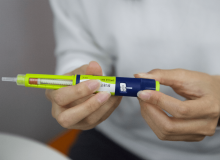To manage diabetes well, people with diabetes need a "good mirror" to ensure measurement accuracy. They also need to have subjective initiative to detect problems and deal with them in a timely manner. What should be done specifically?
Before measuring sugar: 7 preparations to ensure accuracy
1 Bring your own reliable blood glucose meter
Going to the hospital to measure blood sugar often breaks the usual timetable for eating and taking medicine. You may encounter traffic jams on the way to the hospital, or encounter large queues of people after arriving at the hospital, which can cause irritability and often cannot reflect the true situation of blood sugar. , so it is undoubtedly a once and for all choice for patients who have the conditions to buy a blood glucose meter.
When choosing a blood glucose meter, you should "act according to your ability." If your family's income is acceptable, choose an imported brand. If your financial capacity is still at the stage of hard work, choose a domestic and reputable brand. Don't be greedy for cheap.
2 Calibrate the blood glucose meter every month
The blood glucose meter needs to be cleaned and calibrated regularly. The simplest calibration method is to go to the hospital to draw venous blood to measure blood sugar, and also use your own blood glucose meter to monitor blood sugar. If the hospital blood sugar is less than 5.6mmol/L, the blood sugar meter blood sugar should be within the deviation range of ±0.83mmol/L; If the hospital blood sugar is greater than or equal to 5.6mmol/L, the blood glucose meter should be within a deviation range of ±15%.
For example, if the hospital blood sugar is 5.4mmol/L (less than 5.6mmol/L), the blood glucose measured by the blood glucose meter should be between 4.6 and 6.2mmol/L (within the deviation range of ±0.83mmol/L); if the hospital blood sugar is 6.8 mmol/L (greater than 5.6 mmol/L), the blood glucose measured by the blood glucose meter should be between 5.8 and 7.8 mmol/L (within the ±15% deviation range).
It is recommended to calibrate the blood glucose meter once a month. If the deviation is large, you need to consider replacing the blood glucose meter.
3. The test paper and instrument must match
Before testing, be sure to ensure that the barcode value displayed on the blood glucose meter screen is consistent with the barcode on the test strip. Forgetting to adjust the code is the most common cause of errors when testing blood glucose. Of course, you can also consider using a glucose meter that does not require adjustment, which will be much simpler. In addition, the test paper should be stored in a cool and dry place and should not be exposed to the air for too long. Pay attention to the expiration date of the test paper. Do not use it after it expires.
4Wash your hands before taking the test
If your fingers are not "clean", especially if you have grabbed or peeled fruits and have not washed them thoroughly, the measured blood sugar results will be much higher than the real blood sugar.
5Fingers need to be dry
After washing hands or disinfecting with alcohol, be sure to wait until the water or alcohol has evaporated and dried before taking blood. Otherwise, the water or alcohol will dilute the blood and the measured blood sugar value will be lower than the true blood sugar value.
6 blood volume is enough
The blood collection needle should be inserted into the finger to a depth that allows blood drops to naturally escape. If the needle is inserted too shallowly, the blood flow will not be smooth, and the blood squeezed out by hand will be mixed with a lot of tissue fluid, and the blood will be diluted, and the measured blood sugar will be higher than the true blood sugar. of low blood sugar.
7 retest and change hands
If you suspect that the measured blood sugar result is wrong, you should not use the same hand, let alone the same finger. It is best to try again with the other hand. Because pain will stimulate the release of local inflammatory mediators and vasoconstrictor substances, if the blood sugar of the same hand is tested, the results will definitely be different.
After taking a sugar test: Ask yourself 17 questions, self-examination and self-correction
Slight changes in diet, exercise, emotions, sleep, medication, and women's menstrual cycles may affect blood sugar levels. Therefore, when measuring blood sugar, we must take care of all aspects. After measuring blood sugar, ask yourself a few questions, conduct self-examination and self-correction, find out the reasons for high or low blood sugar, and avoid these things that affect blood sugar from now on. event occurs.
・Is the meal time the same as usual?
・Are the meal portions the same as usual?
・Is the variety of food rich?
・Are the types of medicines the same as usual?
・Is the dose of medication the same as usual?
・Is the medication taken at the correct time?
・Do you exercise every day?
・Is the exercise period the same as usual?
・Is the exercise time the same as usual?
・Is the intensity of exercise the same as usual?
・Is your activity level the same as usual?
・Do you experience hypoglycemic meals after exercise?
・Are you unhappy or sad?
・Is there a lot of work pressure?
・Do you have insomnia?
・Did you stay up late?
・Have you ever slept in?
If your blood sugar is high once, don’t worry about it
Many people with diabetes go to the hospital to test their blood sugar once a month or more, and most of the time they test fasting blood sugar to judge the control of diabetes, which is unreliable. If there is an increase in blood sugar, it is best to test again the next day, or test glycated hemoglobin.

